To boost your Amazon Prime Day performance, start developing your strategy a few months beforehand. This will give you a competitive edge and help you achieve profitable results in July.
In this blog, we analyze Prime Day data and share valuable insights from various categories to help you create a winning strategy and improve your Prime Day performance in 2025. Discover our Prime Day stats, data analysis findings, best practices, and expert recommendations to incorporate into your strategy.
Prime Day 2025
In 2024, Prime Day generated $14.2 billion in sales in the US. This year marks the 10th anniversary of the Amazon sales event, known for exclusive deals and discounted prices.
Prime Day 2025 is expected in the second half of July and will last four days instead of the usual two. Amazon’s decision to have a longer sales event is likely due to other platforms and retailers like Walmart and Target increasing their promotion periods.
An extended Prime Day gives customers more room to explore offers and find attractive Prime Day deals, providing you with more opportunities to increase conversions. The same is valid for your competition, so you should start prepping now, especially considering consumer spending trends.
To succeed this year during Amazon Prime Day, you will need a timely and well-structured strategy covering various aspects of what is happening before, during, and after the summer sales event.
Prime Day Strategy Preparation
Blue Wheel’s Amazon advertising specialists have gathered information from their extensive Prime Day experience and various data analysis tools. Our goal is to provide you with comprehensive, data-backed insights and recommendations that you can leverage to enhance your Prime Day performance.
Ahead of Prime Day, you should look at historical data of how traffic and conversions change in the period leading up to Prime Day, as well as during July and August. Consider what you will sell and why. What promotion types can you leverage, and what should the promo discount be? Furthermore, plan your Prime Day strategy around your media budgets and traffic sources.
Prime Day Strategy: Key Elements
A successful Prime Day strategy has 6 key elements. Incorporate them into your plan and prepare on time to improve Amazon Prime Day performance.
- Pre-Event, During Event, Post-Event Planning
- Product Assortment
- Promotion Types and Promo Combinations
- Discounts
- Media Budgets
- Traffic Sources
Blue Wheel’s Data Analysis and Prime Day Strategy
Optimizing Prime Day performance requires strategic planning and data analysis. That is why we have meticulously analyzed data from Similarweb and Stackline, two primary market share data companies.
When comparing our actuals with their assumptions, we noticed they are within 90%. Considering that Amazon doesn’t release all the actuals, it’s safe to say that both companies do a good job of making them directionally close enough that we can make conclusions based on their insights.
Prime Day Strategy and Data Questions
We used the following list of specific questions to analyze the data and get relevant information for brands looking to achieve Prime Day success:
- How are customers searching vs. buying before, during, and after the event?
- How are customers finding products on Amazon during Prime Day?
- Why are the best-performing products and brands successful during Prime Day?
- What types of promotions are they using?
- How are they spending their media dollars?
- How are these products promoted and for how long?
Prime Season Traffic and Conversion Trends
Let’s observe traffic and conversion trends around Prime Day on the Amazon platform. For this purpose, we used data pulled from Stackline. The chart below shows week-over-week (WoW) traffic data for the top 90 SKUs based on sales during Prime Day Week from competing houseware brands.

As you can see in this example, the week before Prime shows a 66% increase in WoW traffic. The traffic drops significantly after Prime Week, with a 68% decline.
For this product category, traffic experiences a significant increase during Prime Week, peaking at 180% WoW. Comparing June to August, traffic rises around 10%, while conversion rates remain relatively unchanged. Although results may differ by category, brands can generally expect a drop in traffic the week following Prime Day.

You will notice different trends when comparing traffic with conversion. There is a lot of browsing before Prime Week, resulting in a 30% WoW drop in conversion. The week of Prime Day shows a 65% week-over-week increase in conversion.
It’s crucial to highlight that the traffic grows by 180% WoW in Prime Week, but conversion only increases by 65% WoW. Although there is a significant jump in traffic during the week of Prime Day, not all of it will lead to conversions, and it will be reflected in your advertising campaigns’ performance.
By mid-August, conversion rates typically revert to mid-June levels, normalizing over time. As expected, there is also a significant drop in conversions the week following Prime Day.
Prime Day Strategy: Traffic Sources in July
The next step in our data analysis was to look at where the traffic in July is coming from. The chart below is based on data across all categories on Amazon from Similarweb, and it breaks down internal versus external traffic. In July, 18% of the on-site traffic came from external sources, and 82% from Amazon.

If you were to compare internal traffic sources like lists, wishlists, and homepages to any other month outside of July, October, and November, you would see these percentages go down significantly. That is because in July, everyone's looking at best deal pages, the homepages, and the store pages more.
If you are not offering promo deals, your traffic is likely to decrease significantly in July. The statistics for Product Pages, Brand Stores, and On-Site Search indicate that consumers are becoming increasingly comfortable with shopping at a store level.
For external sources, the Referral percentage has seen increases year over year. This includes influencers and affiliates who tag brands’ pages. Email traffic is at 1%, which is to be expected, and Direct traffic is at 3% (specific links driving directly to Amazon).
Knowing that 18% of your July traffic is coming from external sources, you should consider how you can combine your DTC and Amazon efforts, instead of keeping them in separate siloes. Consider retargeting tactics in August to improve your Prime Day performance.
Prime Day Promotion Types and Effectiveness by Period
The top promotion types during Prime Week are Best Deals, Prime Day Deals, and Coupons. All three can be run during Prime Week, but Best Deals and Coupons can be run before and after as well.
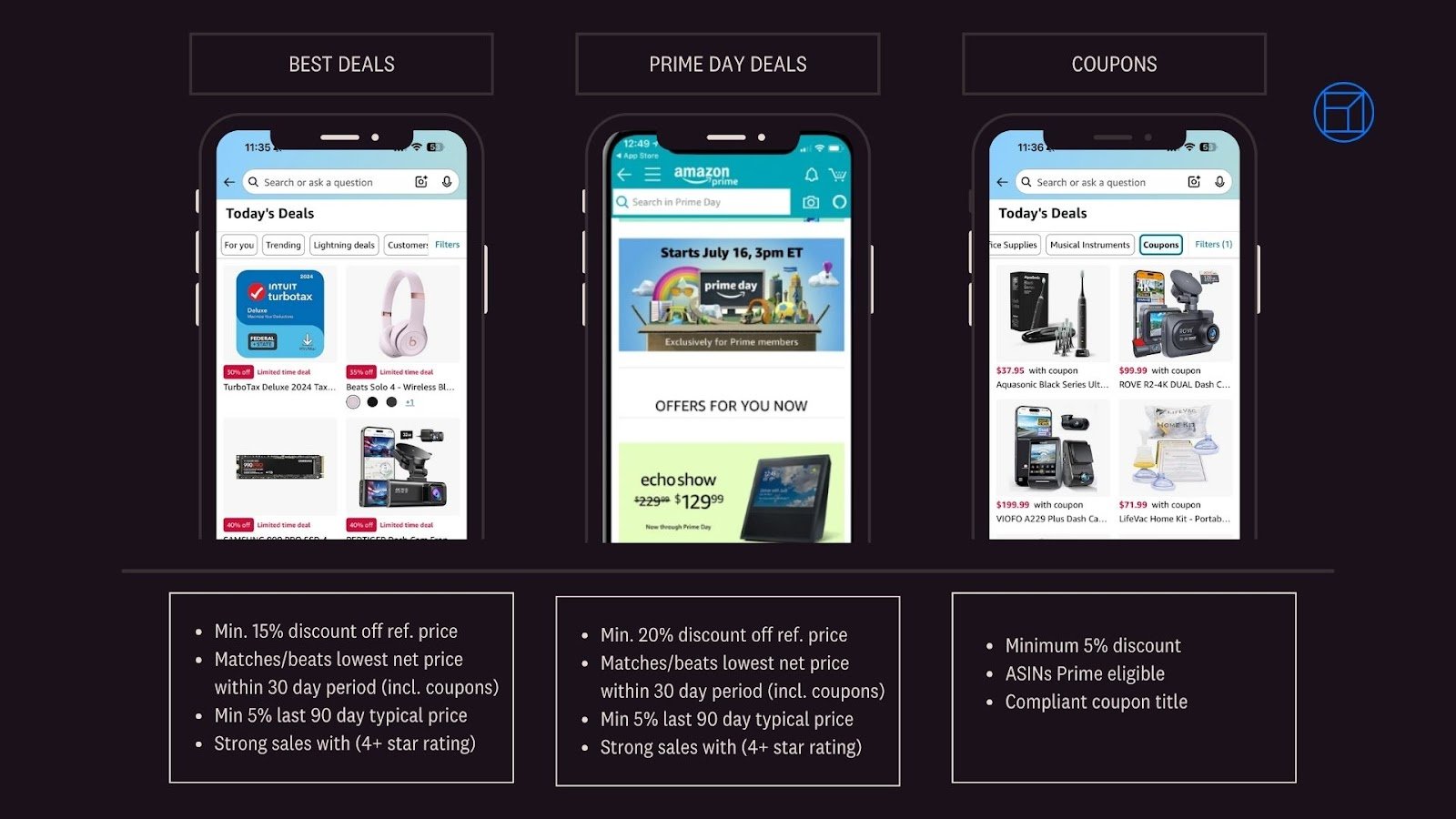
There are different requirements for each promo type, including having at least a 5% discount. If you're discounting a product all year round, you must go higher with your discount during Prime Week. Also, Prime Day Deals and Best Deals need to get approved by Amazon, so ensure you submit them to allow for the approval process.

Based on our research and data pulled from Stackline for the Home & Kitchen category, we analyzed these Prime Day promotions to discover which ones are the most effective by period. We looked at pre-event (two weeks to a month before), during the event, and post-event for brands running all 3 promo types.
Our findings show that Best Deals were the most effective before the event, while Prime Day Deals performed the best during Prime Day, followed by Best Deals. Also, Best Deals were the most effective after the event.
Surprisingly, Coupons were used across all periods but contributed the least to sales. We also discovered that the best-performing brands didn't run any Coupons during Prime Day, which was different from what we would typically see.
The conclusion is that you need to run both Best Deals and Prime Day Deals. But which promo combination would be the most successful and improve your Prime Day performance?
Prime Day Promo Combinations Overview
We used the same Stackline data for the top-performing Home & Kitchen category products to find the best Prime Day promotion combinations. Although this is a specific category, it can help you better understand how to organize promos for the upcoming Prime Day and boost sales.

What we have found is that the best year-over-year sales growth comes from two promo combination strategies:
- Promo 4 weeks leading in, promo during event, full price 4 weeks after
- No promo 4 weeks leading in, promo during event, promo 4 weeks after
For products that were not promoted at any time, all weeks but Prime Week were down in year-over-year sales. Also, discounting during all three periods was not as effective as other combinations. Those without any promotions had a 15% YoY decrease in sales.
Now that you know which two are the best combinations of promos, it’s time to consider what your discounts should look like during those specific periods.
Best Promo Combinations and Prime Day Discounts
Here is what the Blue Wheel team discovered when looking at the two best promo combinations and discount percentages:
- Higher price point items were discounted more. They were discounted in the weeks before and during the event.
- Lower-priced items had lower discounts and were discounted during and after the event.
- Discounts before and after the event were around 10% lower than the week of Prime Day.

Prime Day Strategy: Product Assortment
We looked at different product categories and brands to learn more about how many products brands should focus on. Our team discovered that the 80/20 rule applies to Prime Day, meaning that top brands drive 80% of their sales or more, by 20% or less of their catalog. This is important to remember when considering how you want to allocate your ad budget.
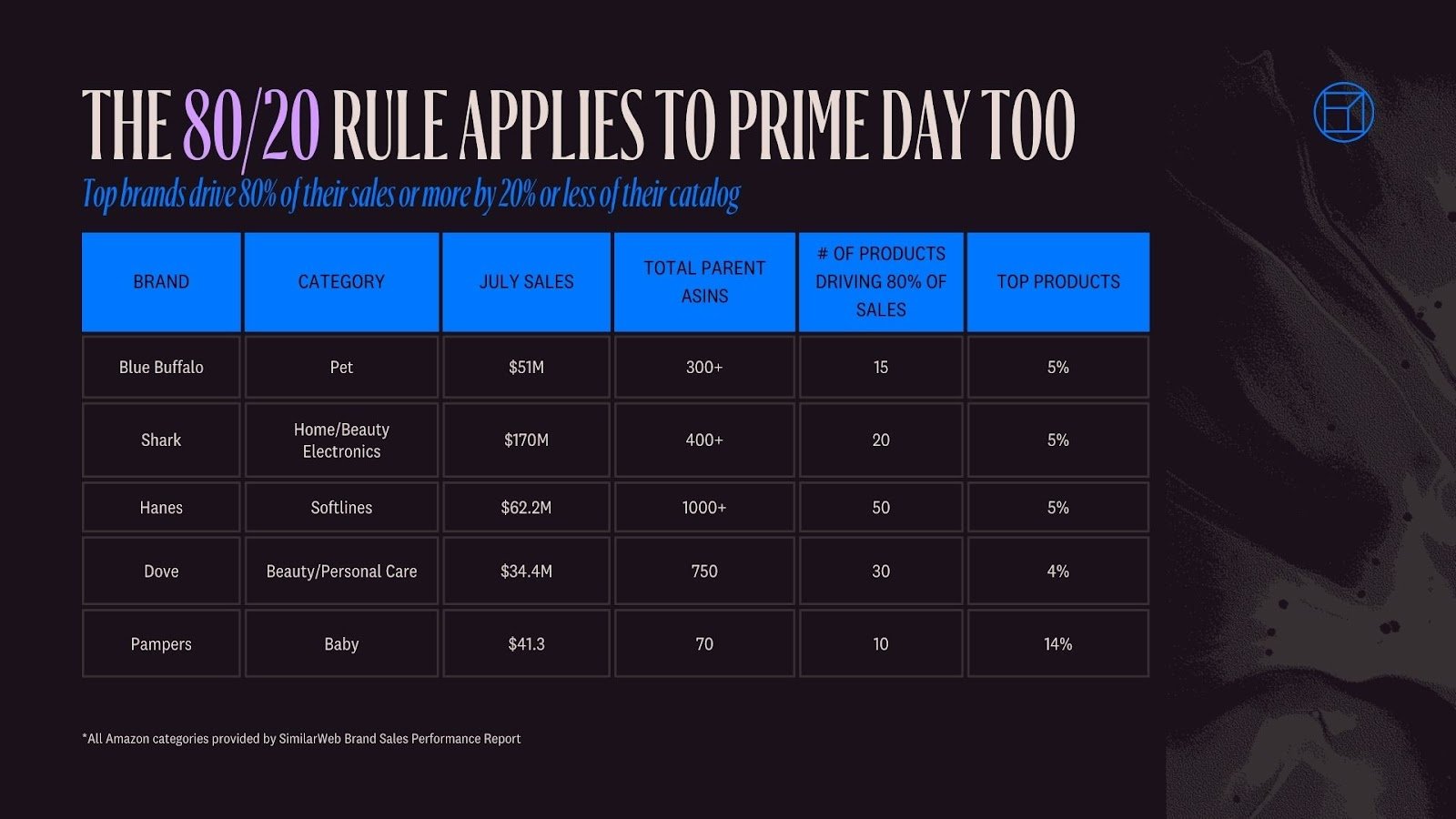
There’s no need to spread your ad efforts too thin. Focus your resources on a select number of products you want to promote. Rather than relying on your entire catalog to perform well, it’s more effective to concentrate your budget on a small number of key items. By doing this, you can achieve better results with your advertising.
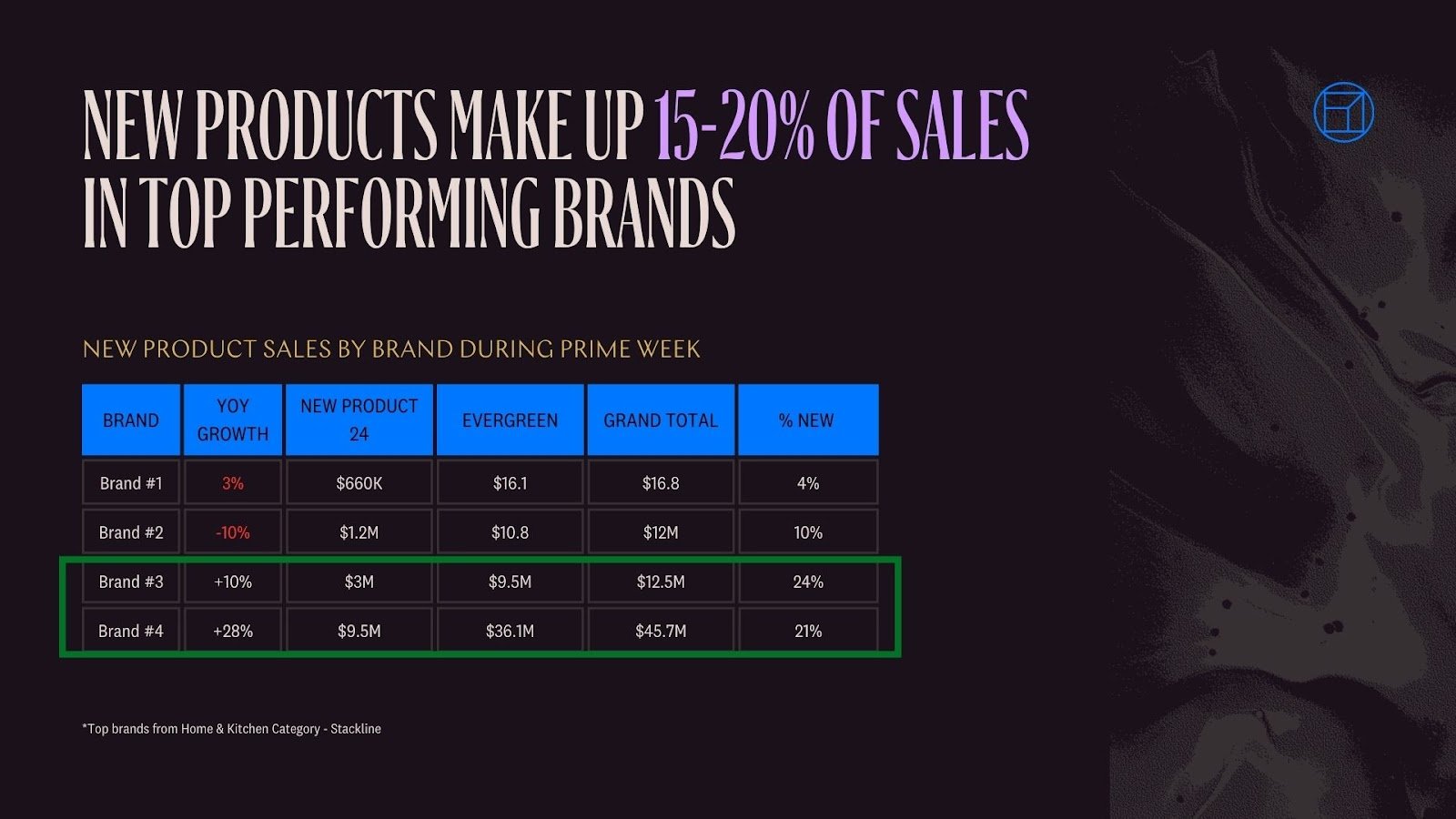
In our next step, we focused on the top four brands in the Home & Kitchen category. We saw that many successful brands had a large portion of their sales come from new product launches. In other words, products that make up 15 to 20% of their sales hadn't been on the site in the prior year. Looking at the chart above, you can see that having new product launches before the Prime Day event has a significant impact on sales.
Prime Day Strategic Execution
Based on our thorough research and findings about traffic and conversion, we have developed a structured plan for allocating your budget for June, July, and August.

By analyzing top brands, we found that traffic allocation in June and August was about 25% of the budget, and in July it was 50%. Interestingly enough, many brands spent too much in June, and July and August would have the same budget.
For week 1 of July, we found that most successful brands spent about 10% of their budget. In week 2, they spent 20%, followed by 50% in week 3 and 20% in week 4.
Top 5 Amazon Ads Tips for Prime Day
We made a practical list of Amazon Ads tips that can be implemented into your advertising strategy and help you optimize Prime Day performance.
- Advertise Deal ASINs to Support Sales and Traffic: Brands that advertised deal ASINs with Amazon Ads saw an average detail page view increase of 1.9x-2.0x, and an average sales increase of 2.1x-2.3x compared to unadvertised deal ASINs, based on Amazon’s Internal Data.
- Leverage Amazon DSP Ads to Promote Deal ASINs: Amazon DSP responsive display creatives can be used to show strikethrough pricing and deal messaging to draw attention to deal ASINs.
- Implement Interactive Video Ads to Drive Engagement for Deal ASINs: Prime Video and Streaming TV creatives can be enhanced with remote clickable call-to-actions or QR codes to allow customers to shop for a deal ASIN while browsing video content.
- Utilize Brand Store to Promote Deals: The Featured Deals widget allows customers to quickly discover your brand’s deal ASINs from the Brand Store. Reference the Promotions and Featured deals policy for additional details.
- Control Top of Search Placements With Deal ASINs: Focus on promoting deal ASINs in Sponsored Brands to highlight them at the top of search results.
Blue Wheel’s Checklist: Pre-Prime, Prime Day, Post-Prime
Before Prime Week, you want to capture early browsing interest, drive brand awareness, and optimize Product Detail Pages before conversion peaks. Increase your upper funnel ad spend at least 2-3 weeks before the event and leverage external traffic to drive early engagement. Remember our findings on high-ticket and lower-priced items as you work on your discount strategy.
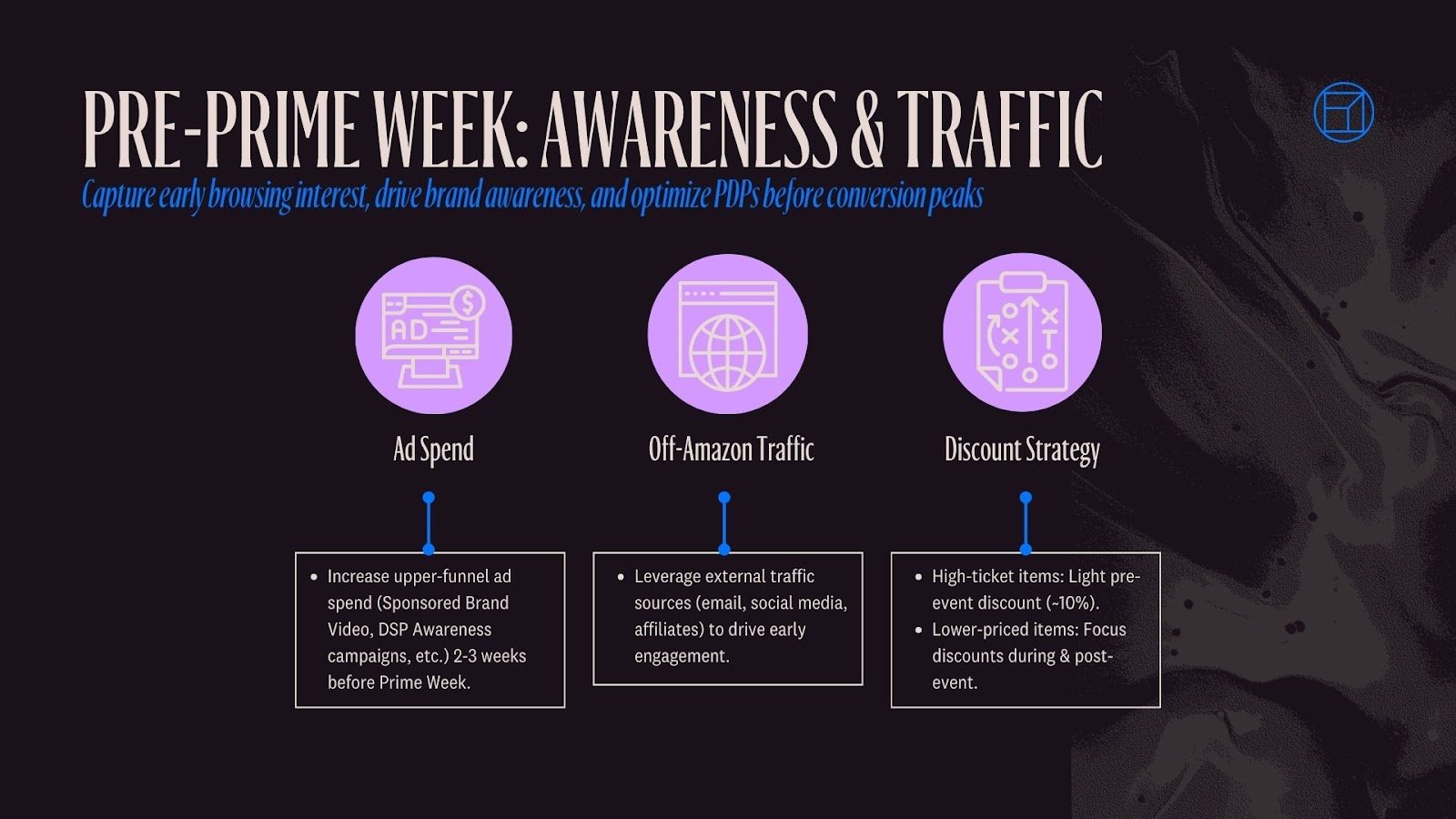
During Prime Week, you want to capitalize on peak traffic and drive high conversion rates with more strategic promotions. Allocate over 30% of the total 3-month budget for Prime Week, bid aggressively on your high-performing keywords, monitor performance, and adjust your budget accordingly.
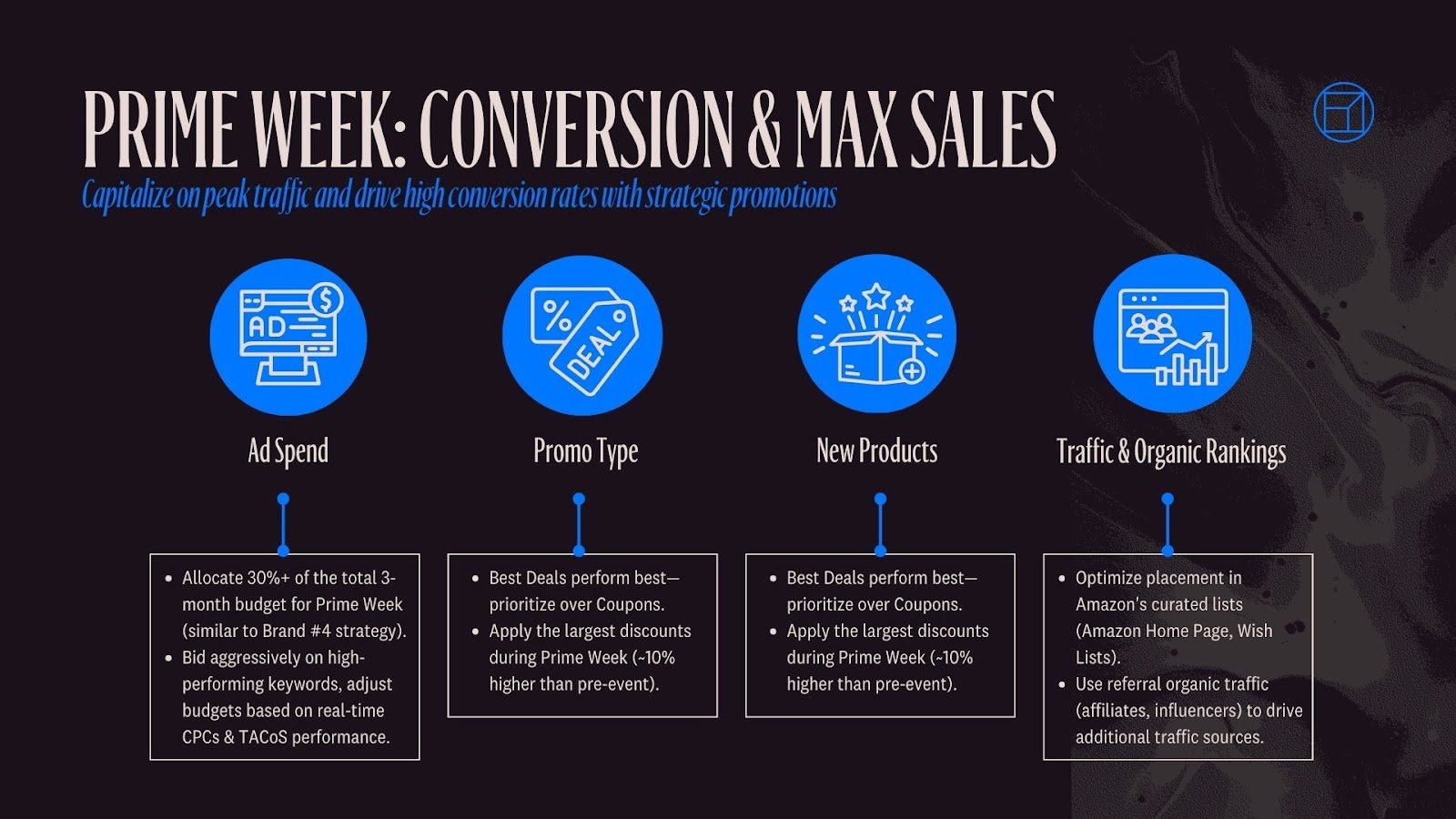
Prioritize Best Deals over Coupons, as they perform best during Prime Week and apply the biggest discounts during Prime Week, at least 10% higher than pre-event. Focus on your new products and think about your traffic and organic ranking.
Consider your curated list and how you should start engaging with customers before Prime Week. How can you show them that discounts are coming, so that they add products to their wish list before and then purchase during the event? Use referral organic traffic, like affiliates and influencers, to drive additional traffic sources.

After Prime Week, you want to sustain traffic and sales by capitalizing on post-event traffic. Think about retargeting, reducing your ad spend by 50% in August, and reallocating those budgets to July. Consider which of the two most effective promo strategies works best for your brand. For conversion optimization, continue enhancing your Product Detail Pages and retarget shoppers from Prime Week.
Prime Day Discounting and Pricing Strategy
Here is our suggested strategy for maximizing sales while maintaining profitability across different product tiers:
- Big-Ticket Items: These items should be paired with higher discounts pre-event and during Prime Week.
- Lower-Priced Items: These items can have lower discounts but focus on Prime Week and post-event promotions.
- Avoid Excessive Discounting: Discounts pre-event, during, and post-event are less effective than strategic combinations. Maintain full price after the promo event to recover margins.
Prime Day Strategy: Key Takeaways and Summary
As you’re getting ready to work on your Prime Day strategy for this year’s 4-day event, here are some of the key takeaways to keep in mind:
- Consider narrow assortment focus: Deep discount and ad spend
- Plan traffic and conversion KPIs by week: Expect a drop in CVR one week prior and one week after; traffic will outpace CVR during Prime Week.
- Best Deals and Prime Day Deals promo types work best based on our research
- Promote before or after the event and avoid discounting products during all three phases.
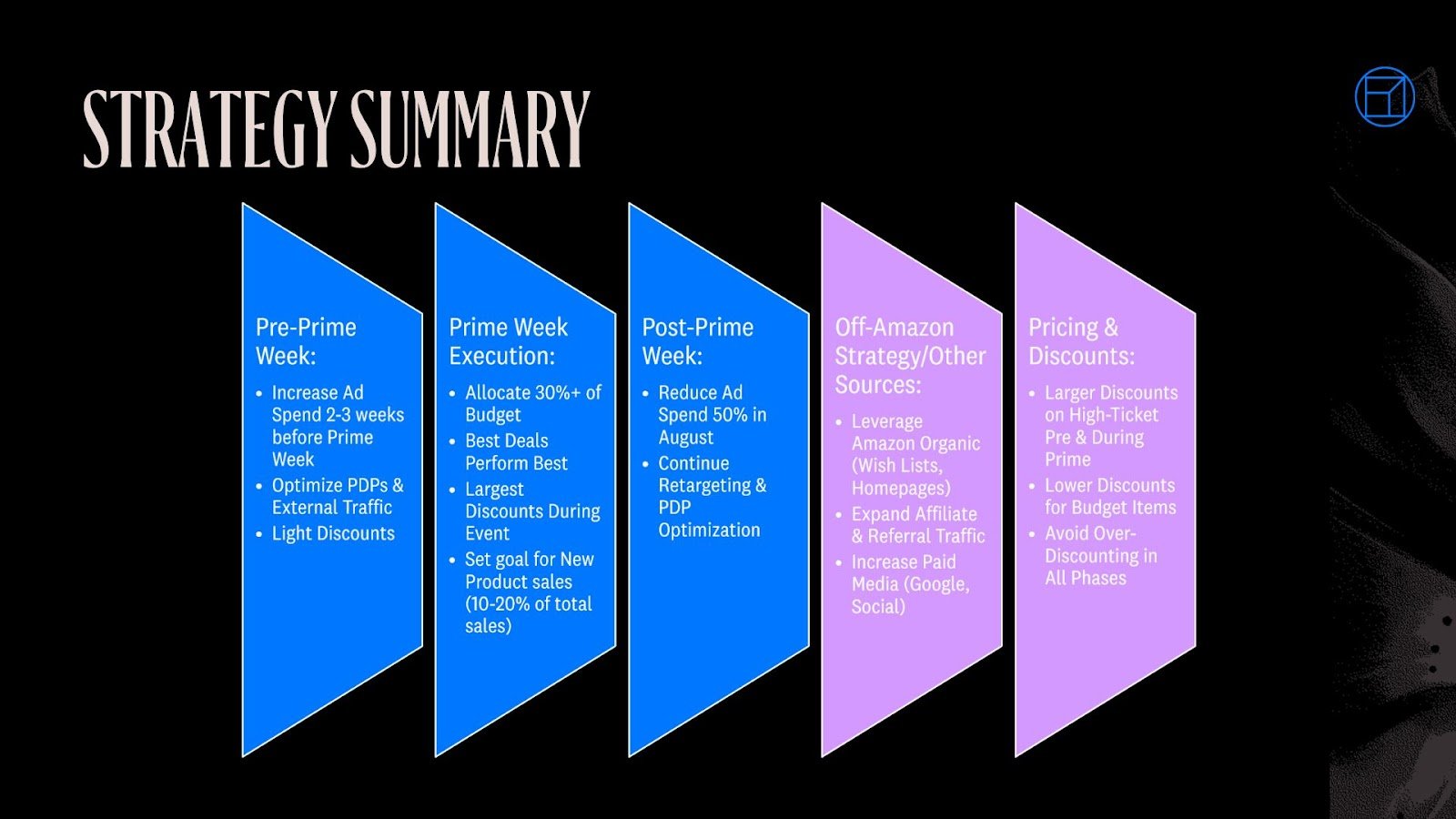
To learn more, we recommend watching our latest webinar, Data-Backed Prime Day Strategies for eCommerce Brands. Our session in partnership with BWG Connect explores key steps for strategic preparation and ways to boost your Amazon Prime Day performance.
Blue Wheel expert and Chief Revenue Officer, Nicole Reich, addresses some of the most pressing questions leading up to Prime Day and offers practical advice for brands.




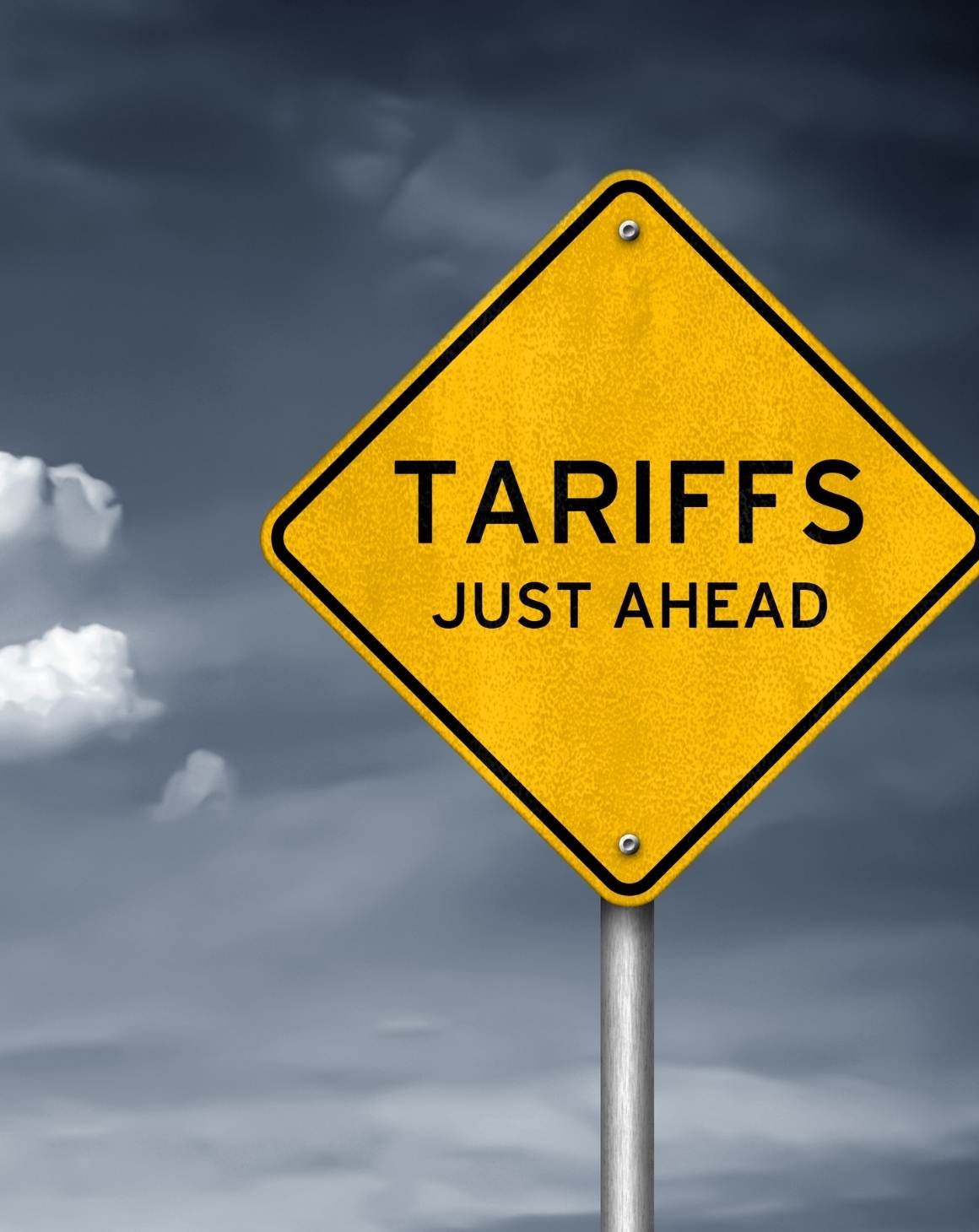



.png)
.png)
